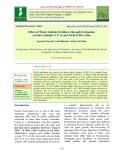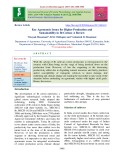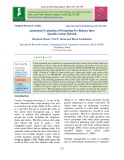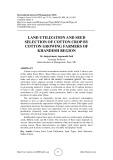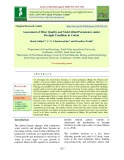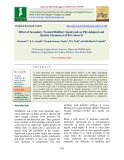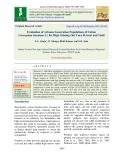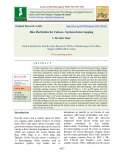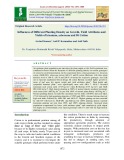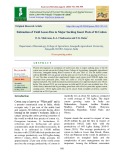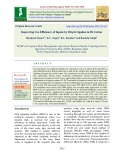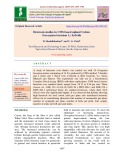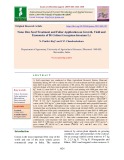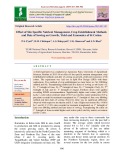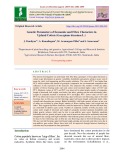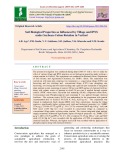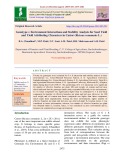
Higher yield of cotton
-
The soil available N, P and K were significantly higher in treatment supplemented with application of 100 per cent RDF through soluble fertilizers by fertigation over 100 per cent RDF through conventional fertilizers. Yield was significantly maximum in application of 100 per cent RDF through soluble fertilizers by fertigation than other treatments.
 5p
5p  chauchaungayxua11
chauchaungayxua11
 23-03-2021
23-03-2021
 11
11
 2
2
 Download
Download
-
With the advent of Bt cultivars cotton production is reinvigorated in the country with China being on the verge of being knocked down on the production front. However, of late the stagnating or the decreasing productivity either due to degrading natural resources and faulty practices and/or susceptibility of transgenic cultivars to insect damage, leaf reddening and climate change are making the researcher to take stock of the situation before embarking on agronomic studies with higher yield goals. Hence, the review.
 19p
19p  angicungduoc8
angicungduoc8
 07-11-2020
07-11-2020
 13
13
 2
2
 Download
Download
-
Field experiment was conducted at Agricultural Research Station, Borwat Farm, Banswara during kharif -2011 to find out the optimum plant geometry and fertility levels for inter specific cotton hybrids with three cotton hybrids (USHB-25,PSCHB-901 and DCH-32), two plant geometries (90 x 60 and 90 x 45 cm) and three fertility levels (75,100 and 125 % RDF). Sowing of USHB-25 cotton hybrid gave significantly higher seed cotton yield (2354 kg ha-1 ) over PSCHB-901.
 4p
4p  chauchaungayxua8
chauchaungayxua8
 03-10-2020
03-10-2020
 8
8
 1
1
 Download
Download
-
Cotton crop is cultivated in maximum countries of the world. Cotton is one of the oldest finest fibers. These fibers are most often spun in to thread and used to make a soft, breathable textile.
 8p
8p  murielnguyen
murielnguyen
 01-07-2020
01-07-2020
 6
6
 2
2
 Download
Download
-
To investigate the water-deficit tolerance, 3 cotton genotypes (Bunny Bt, Pratima and Anjali.) were grown under normal irrigation and water-deficit conditions. Moisture is a key factor affecting growth and yield of Cotton in which stress is the most important factor limiting crop productivity due to adverse effect on fruit production, square/boll shedding and lint yield as well as fiber quality properties of Cotton. If water supply is limited during boll development it could result in significantly lower yields. In this study stress imposed with four watering treatments viz.
 8p
8p  angicungduoc6
angicungduoc6
 22-07-2020
22-07-2020
 17
17
 1
1
 Download
Download
-
A field experiment was conducted during Kharif season of 2014-15 to evaluate the Effect of High Density Planting System (HDPS) and Genotypes on growth parameters and Yield contributing traits in upland cotton at Cotton Research Unit, Dr. P.D.K.V., Akola. The experiment was laid out in FRBD design consisting of four factors of plant densities viz., 45 x 10, 60 x10, 75 x 10 and 60 x 15 cm2 in main plots and three factors of cotton varieties i.e., AKH-081, NH-615 and Suraj in sub plots with replicated thrice.
 7p
7p  quenchua6
quenchua6
 15-06-2020
15-06-2020
 24
24
 1
1
 Download
Download
-
A field experiment was conducted during Kharif 2010-11 at the Main Agricultural Research Station, University of Agricultural Sciences, Dharwad to study the response of secondary treated distillery spentwash on physiological and quality parameters of Bt cotton under rainfed condition. Result indicated that application of 1.5 N through distillery spentwash significantly increased the total dry matter production (339.7 g plant-1 ), leaf area (51.3 dm2 plant-1 ), LAI (0.95), good opened bolls plant-1 (31.2) and yield (2566.1 kg ha-1 ), but was on par with 1 N through spentwash.
 6p
6p  quenchua6
quenchua6
 15-06-2020
15-06-2020
 22
22
 2
2
 Download
Download
-
The objective of study was to develop high yielding (>20quintals/hectare) and high ginning out turn per cent (>35) cultures/ varieties. Out of 19 advance generation, three advance generation individual populations RS875xSA524 P12, F1861xSA668 P15, RS875xSA524 P4 had significantly higher seed cotton yield in comparison to both the check varieties H1226 (1717.37±292.3) and (F1861 1751.09 ±292.3) and possessed GOT% of 40.6, 38.5 and 39.0 and lint yield 935.6, 848.0 and772.4kg/ hectare, respectively.
 9p
9p  kethamoi5
kethamoi5
 03-06-2020
03-06-2020
 12
12
 0
0
 Download
Download
-
A field experiment was conducted at Central Institute for Cotton Research Farm, Nagpur for three years in medium deep clay loam soil. The experiment was laid out in RBD design with three replications consist of three herbicide based weed management packages in intercropping of non Bt cotton + soybean and two sole crops. Non Bt cotton+ soybean intercropping reduced seed cotton yields considerably in a year of very 640 mm higher rainfall over normal caused over growth of soybean.
 9p
9p  trinhthamhodang1213
trinhthamhodang1213
 29-05-2020
29-05-2020
 12
12
 0
0
 Download
Download
-
An optimum plant population can maximize the plant output so this field experiment was conducted to know about the Response of different planting density on various genotypes of cotton for yield maximization. In this experiment three cotton genotypes viz. hirsutum cotton (AKH-081), arboreum cotton (AKA-7) and Bt cotton (Balwan), with three plant densities level of 100 %, 150 % and 200 % of normal for respective genotype, were laid out in factorial randomized block design. Bt cotton Balwan recorded higher growth in terms of leaf area, dry matter weight and yield attributes plant-1 .
 16p
16p  chauchaungayxua5
chauchaungayxua5
 08-05-2020
08-05-2020
 14
14
 1
1
 Download
Download
-
Present investigation on estimation of yield losses due to major sucking pests of the Bt cotton was carried out on the College Farm, College of Agriculture, Junagadh Agricultural University, Junagadh during Kharif season of the year 2011-12. The Bt hybrid cotton cultivar KDCHH-441 was grown with the plot size of 24 m X 20 m at spacing of 120 cm x 45 cm. The data revealed that significantly higher seed cotton yield 2038.82 kg/ha was recorded from protected plots, while the yield of 1312.70 kg/ha was recorded from unprotected plots.
 4p
4p  angicungduoc4
angicungduoc4
 26-04-2020
26-04-2020
 7
7
 0
0
 Download
Download
-
Crop diversification with resource efficient and remunerative cropping systems is a sustainable agricultural practice. On farm demonstrations with diversified cropping system of Redgram + soybean Vis-a-Vis farmers’ practice of sole cotton were conducted in ten farmer’s locations of Warangal district of Telangana state. Crop diversification with red gram + soybean realized 29.9% higher (3706 kg ha-1 ) mean cotton kapas equivalent yield over farmer’s practice of cultivation of sole cotton (2852 kg ha-1 ). Mean technology and extension gap were 594 kg ha-1 and 854 kg ha-1 respectively.
 8p
8p  nguathienthan4
nguathienthan4
 18-04-2020
18-04-2020
 12
12
 1
1
 Download
Download
-
An experiment was conducted during two consecutive years of kharif 2012 and 2013 at Agricultural Research Station, Banswara to find out the suitable drip irrigation regimes and optimum nitrogen dose for Bt cotton. The experiment was laid-out in split plot design with four replications having twelve treatment combinations. Results revealed that, the application of irrigation at 0.6 ET gave significantly higher seed cotton yield (1989 kg/ha) as compared to irrigation regime of 1.0 ET and surface irrigation (control),but it was found at par with application of irrigation at 0.8 ET (1905 kg/ha).
 7p
7p  trinhthamhodang1212
trinhthamhodang1212
 06-04-2020
06-04-2020
 13
13
 1
1
 Download
Download
-
The 1329 F2, 174 B1 and 191 B2 plants were evaluated along with parents (Suvin and BCS 23-18-7) and its F1 for seed cotton yield and its component traits and fibre quality traits. Top 20 transgressive segregants were selected for seed cotton yield from all three segregation generations (F2, B1 and B2), recorded 104.02 to 169.46 per cent higher seed cotton yield than best parent BCS 23-18-7 (116.90 g/plant). Six transgressive segregants recorded 5 per cent early flowering (< 65 days) with a minimum of 50 per cent yield advantage (> 177 g) over BCS 23-18-7.
 12p
12p  trinhthamhodang4
trinhthamhodang4
 22-03-2020
22-03-2020
 9
9
 1
1
 Download
Download
-
A study of heterosis over checks was carried out with 24 Gosypium hirsutum entries comprising of 14 F1s produced by CMS method, 7 females and 2 males and 1 check were evaluated at three locations viz., Surat, Bharuch and Hansot. The experiment was laid out in a Randomized Complete Block design (RBD) with three replications. CMS based crosses heterosis over standard check ranged from -39.17 to 9.36 per cent. Three crosses viz., G(B) 20 x G.Cot.10, G(B) 20 x DHY-286-1 and LRK-516 x DHY-286-1 performed better for standard heterosis, where their SCA effects were also significantly higher.
 8p
8p  caygaocaolon3
caygaocaolon3
 09-03-2020
09-03-2020
 13
13
 0
0
 Download
Download
-
A field experiment was conducted at Main Agricultural Research Station, Dharwad, Karnataka, during 2017-18 to evaluate the effect of seed treatment and foliar application of nano ZnO on growth, yield and economics of Bt cotton.
 7p
7p  cothumenhmong3
cothumenhmong3
 22-02-2020
22-02-2020
 21
21
 0
0
 Download
Download
-
A field experiment was conducted at Agronomy Farm, University of Agricultural Sciences, Raichur in 2015-16 on effect of site specific nutrient management, crop establishment methods and date of sowing on growth, yield and economics of Bt cotton. The experiment was laid out in Split Plot Design (SPD) with three replications. Two methods of crop establishment as main factor viz. M1: Dibbling method and M2: Transplanting method and five dates of sowing as sub factor viz.
 7p
7p  trinhthamhodang3
trinhthamhodang3
 12-02-2020
12-02-2020
 16
16
 0
0
 Download
Download
-
The present investigation was performed with fifty-three genotypes of Gossypium hirsutum L. cotton to get information on genetic variability, heritability and genetic advance as per cent of mean for yield, yield supporting and fibre quality attributes. The value of PCV was higher than GCV which explains that instead of genotypic component, the environmental component also influences in the expression of the character. The characters like number of bolls per plant, number of flower bearing nodes and seed cotton yield recorded higher values of GCV and PCV.
 7p
7p  chauchaungayxua3
chauchaungayxua3
 07-02-2020
07-02-2020
 29
29
 0
0
 Download
Download
-
The present investigation was conducted during kharif 2016-17 with a view to study the effect of various tillage and IPNS practices on soil biological properties under soybean – cotton rotation in Vertisol. The experiment was conducted at Research Farm, Department of Soil Science and Agricultural Chemistry, Dr. PDKV, Akola. The experiment was carried out with main plot comprises two treatments i.e.
 10p
10p  chauchaungayxua3
chauchaungayxua3
 07-02-2020
07-02-2020
 17
17
 0
0
 Download
Download
-
Twenty six genotypes were evaluated for G × E interaction and stability analysis in three environments viz., Castor-Mustard Research Station, S. D. Agricultural University, Sardarkrushinagar (E1), Cotton Research Station, S. D. Agricultural University, Talod (E2) and Agricultural Research Station, S. D. Agricultural University, Kholwada (E3) (Gujarat, India) during kharif-rabi 2016-17.
 7p
7p  nguathienthan2
nguathienthan2
 26-12-2019
26-12-2019
 35
35
 0
0
 Download
Download
CHỦ ĐỀ BẠN MUỐN TÌM









